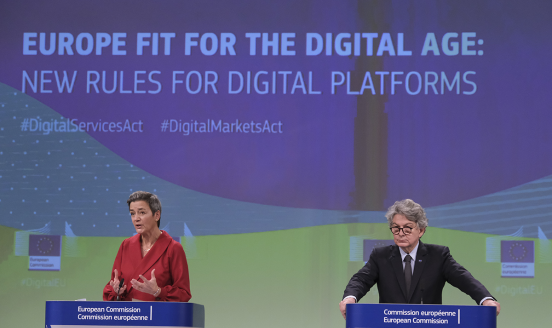Intellectual Property Rights and Antitrust – is there light at the end of the tunnel? Part 2
Part 2/2
In my previous blog I wrote about the work of the European Union and United States competition authorities’ chief economists on a set of common principles that could improve standard-setting processes and limit ex-post abuse. To recap, the preliminary list circulated two weeks ago in the US contains four suggested principles (see Fiona Scott Morton’s, DOJ’s chief economist, slides): (1) commitments remain with IP regardless of owner; (2) well – specified procedure to lower cost of dispute resolution; (3) cash option; (4) well-specified process before an injunction/exclusion sought. Below are some first impressions on that list.
Principle 1 makes lot of economic sense. Imagine a licensor could commit to FRAND and then sell a FRAND-free patent to another company. The buyer would not abide by FRAND commitments and therefore would charge royalties higher than those that would have been charged by the original patent holder. To the extent that FRAND is binding (ie the royalties that maximise the patent holder's profits are above the FRAND level), original patent holders would then always have an incentive to sell their patents to other companies. This would generate an extra rent to be split between the original and the new patent holders on the basis of their respective bargaining power. At the equilibrium, all patents with a binding FRAND commitment would be sold and FRAND would be totally emptied.
At least on the European side of the Atlantic, this principle is, however, not new. The European Commission has already been confronted with cases involving the transfer of IP rights subject to FRAND commitments (eg IPCom versus Nokia), and has endorsed the principle in its new guidelines on the applicability of Art. 101 TFEU to horizontal cooperation agreements. According to paragraph 288 of the guidelines: "to ensure the effectiveness of the FRAND commitment, there would also need to be a requirement on all participating IPR holders who provide such a commitment to ensure that any company to which the IPR owner transfers its IPR (including the right to license that IPR) is bound by that commitment, for example through a contractual clause between buyer and seller". ETSI, the European telecommunication standards body, is reported to have reached a consensus on this principle (see MLex coverage on October 18: Etsi eyes consensus on tech licensing terms for patent transfer).
Because it aims to speed up the resolution of patent disputes, Principle 2 is also very welcome. The difficulty here is to suggest a design that would not tilt the balance of power in favour of either of the involved parties. For example, defining an "allowed range of FRAND royalty rate" before the adoption of a standard could threaten to empty the meaning of FRAND. Since standards are adopted under conditions of very high uncertainty, FRAND commitments are on purpose designed to be flexible. At the time of the selection of the standard, patent holders and prospective licensees may not be able to correctly foresee what the future value of the technology would be. The market has not yet materialised and consumers have not yet expressed their preferences. In that sense, FRAND aims at reducing the risk of abuse of ex-post market power while maintaining a high degree of flexibility, in order to allow the price of the patents to adjust to future market developments, when consumers' preferences are revealed. Defining an allowed range of royalties ex-ante could therefore boil down to diverting FRAND from its true purpose.
Likewise, Principle 3 aims to make negotiation processes more efficient and transparent, but its implementation is not straightforward. While patent holders may have a better idea than third parties of the value of their patent portfolio, they would still struggle to put a price tag on their patents before the adoption of the standard, while the standard itself is being forged and the degree of uncertainty is very high. The value of a patent portfolio is often defined through negotiation. It is the interaction between different companies (licensors or licensees) with different endowments, commercial strategies and bargaining power, which ultimately brings out the value of the patents. How companies would define the cash option is not straightforward, and guidance on how principle 3 should be implemented is therefore indispensable.
Principle 4, finally, questions the patent holder's ability to seek injunctive relief against an infringing company. The underlying economic argument is appealing: injunctions create immediate, short-term and certain harm to consumers because they interrupt actual supply. Limiting access to injunctions would keep the market going and spare consumers from this short-term pain. And it should not affect innovation incentives because the patent holder would still be able to claim compensation later on in the process. This reasoning however crucially depends on the assumption that the judicial system is perfectly efficient and capable of determining the right price for patents, and that investors perfectly anticipate this outcome. If that is not the case, different companies are likely to be affected in different ways by the introduction of a limitation to the right to seek injunctive relief. A small innovative company or start-up with limited financial resources is likely to be affected differently than a "patent troll", and so are different companies' incentives to innovate. The prospect of a lengthy judicial process with an uncertain outcome might simply not be a viable option for companies that rely completely on licensing to reward their initial investment decisions. In other words, courts are only imperfect substitutes for arms-length negotiations, and the distribution of rents between patent holders and prospective licensees is not independent of the allocation of the right to injunctive relief. Interfering with that right implies a redistribution of rents, which ultimately might lead to higher social welfare, but is not a free-lunch: somebody has to lose. The design of the rules limiting the use of injunctive relief should therefore be flexible enough to allow for a more lenient approach when ex-ante incentives to innovate are under threat. Protecting incentives is the raison d'être of patents, after all.
There is also an argument of principle that supports limiting the use of injunctions in relation to FRAND-bearing patents. According to Scott Morton: "the essence of the F/RAND commitment is that the firm has voluntarily chosen to accept royalties (money) rather than pursue a business model based on exclusion". That is true, but only to the extent that a licensee is willing to pay royalties which are, indeed, FRAND. The FRAND commitment implies a willingness of both licensor and licensee to negotiate at arms-length. The key question to address when deciding whether to allow an injunction is therefore: has a patent holder complied with its duty of good will and engaged in a constructive negotiation with the licensee in order to achieve a mutually satisfactory solution? If hard evidence (emails, phone records etc) show that this is the case, the right to seek an injunction cannot be questioned on the basis of principle but should be evaluated on effects with a case-by-case approach.
Summing up, the fact that the EU and US competition authorities' economists are working on solutions to improve the standard-setting process is certainly good news. The proposed principles, however, seem to raise a number of issues, and rigorous economic analysis will be needed in order to understand if their adoption will have a positive effect on consumers, both in terms of fostering price competition and preserving incentives to innovate.
Moreover, besides economics, one policy question should still be addressed: provided that the principles are backed by economic analysis, when the list of suggestions is finalised, how could they effectively bind standard-setting organisations? In what form will they be communicated to the outside world? Would they be "recommendation" letters to standard-setting organisations or will they be made part of new guidelines? The tool that will be used and the chosen trade-off between speed of process and enforceability will ultimately have great relevance. For the moment, we should expect that most guidance on the interaction between IP and competition policy will continue to come from case law. So the answer to our question: is there light at the end of the tunnel? cannot be conclusive for the moment. The competition authorities appear to be making a first step in the right direction. However, designing the right principles to minimise competition issues in standard-setting is not a straightforward process. And even if there is light, reaching the end of the tunnel will still take some time.



